Petrogenesis and Tectonic Setting of the Baluogenguole Mafic Dykes, Zongwulong Belt: Implications for Evolution of the Northern East Paleo-Tethys Ocean
Abstract
1. Introduction
2. Geological Setting
3. Geology and Sample Descriptions of Baluogenguole Mafic Dykes
4. Analytical Methods
4.1. Whole-Rock Geochemical Analysis
4.2. Zircon U-Pb Dating
4.3. Zircon Lu–Hf Isotopes
4.4. Whole-Rock Sr-Rb and Sm-Nd Isotope Analysis
5. Results
5.1. Whole-Rock Major and Trace Elements
5.2. Zircon U-Pb Geochronology
5.3. Sr-Nd–Hf Isotope Compositions
6. Discussion
6.1. Post-Magmatic Alteration
6.2. Petrogenesis and Magma Sources
6.2.1. Crustal Contamination
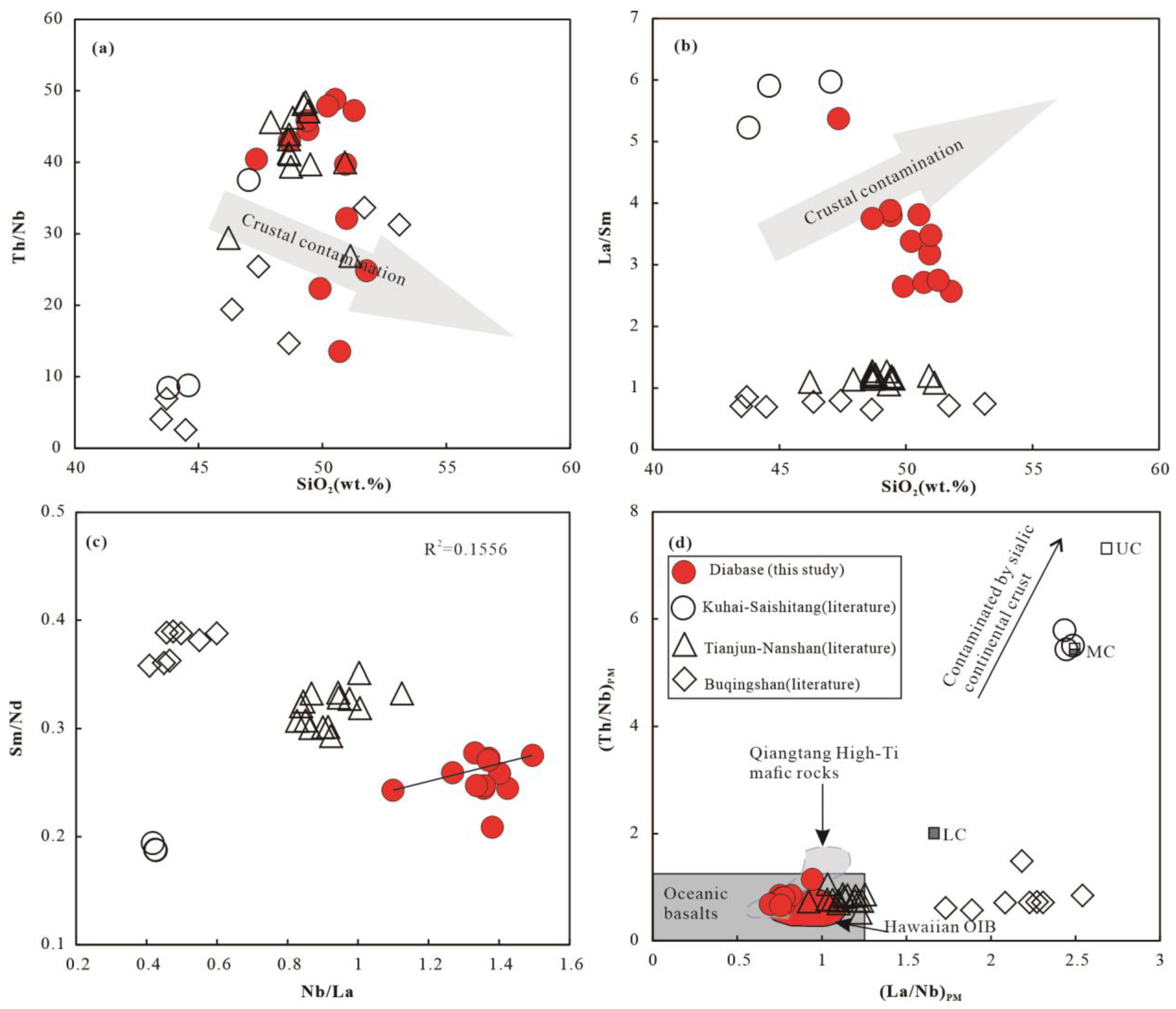
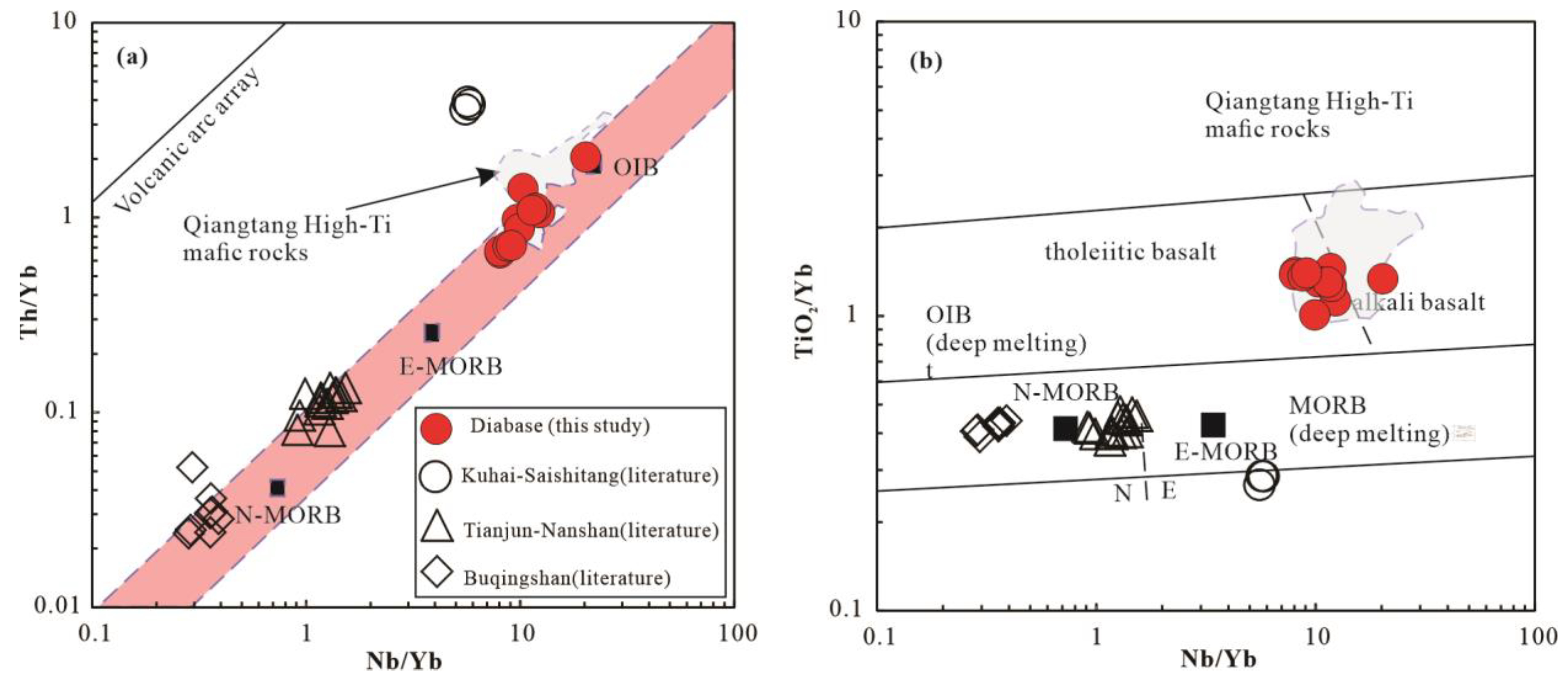
6.2.2. Fractional Crystallization
6.2.3. Magma Source
6.3. Tectonic Implications
6.3.1. Tectonic Setting
6.3.2. The Most Distant North Branch of the East Paleo-Tethys Ocean in the ZWLB
7. Conclusions
- The zircon U-Pb dating of the newly discovered Baluogenguole mafic dykes yielded ages of 289.3 ± 1.2 Ma, and are interpreted as existing in the age of intrusion.
- The Baluogenguole mafic dykes underwent negligible crustal contamination, and experienced extensive fractional crystallization of olivine, clinopyroxene, and Fe-Ti oxides but not of plagioclase. They were produced from the spinel–garnet transition zone at depths of ~75 km, and garnet facies low-degree melting (5–10%).
- The Baluogenguole mafic dykes were formed in a continental rift setting. Combined with the regional geological data, the ZWLB likely experienced a continental rift in the west and a narrow oceanic environment in the east, possibly making it the most distant north branch of the East Paleo-Tethys Ocean.
Supplementary Materials
Author Contributions
Funding
Data Availability Statement
Acknowledgments
Conflicts of Interest
References
- Guo, A.L.; Zhang, G.W.; Sun, Y.G.; Cheng, S.Y.; Qiang, J. Sr-Nd-Pb isotopic geochemistry of Late-Paleozoic mafic volcanic rocks in the surrounding areas of the Gonghe basin, Qinghai Province an geological implications. Acta Petrol. Sin. 2007, 23, 747–754, (In Chinese with English abstract). [Google Scholar]
- Wang, Y.Z.; Bai, Y.S.; Lu, H.L. Geological characteristics of Tianjunnanshan ophiolite in Qinghai and its forming environment. Qinghai Geol. 2001, 29, 29–35, (In Chinese with English abstract). [Google Scholar]
- Chen, L.; Sun, Y.; Pei, X.; Gao, M.; Feng, T.; Zhang, Z.; Chen, W. Northernmost paleo-tethyan oceanic basin in Tibet: Geochronological evidence from40Ar/39Ar age dating of Dur’ngoi ophiolite. Chin. Sci. Bull. 2001, 46, 1203–1205. [Google Scholar] [CrossRef]
- Yue, Y.; Dong, Y.; Sun, S.; He, D.; Hui, B.; Ren, X.; Zhang, B.; He, W. Mafic-ultramafic rocks in the Buqingshan Complex of the East Kunlun Orogen, northern Tibetan Plateau: Remnants of the Paleo-Tethys Ocean. Int. Geol. Rev. 2022, 64, 3149–3170. [Google Scholar] [CrossRef]
- Wang, B.Z.; Zhang, Z.Y.; Zhang, S.Q.; Zhu, Y.T.; Cao, S.X. Geological features of lower Paleozoic ophiolite in Kuhai-Saishitang region, eastern section of Eastern Kunlun. Earth Sci. J. China Univ. Geosci. 2000, 25, 592–598, (In Chinese with English abstract). [Google Scholar]
- Li, P.A.; Nie, S.R. Structural characteristics of Zongwulong rift. Geol. Qinghai 1982, 65–76, (In Chinese with English abstract). [Google Scholar]
- Bureau of Geology and Mineral Resources Qinghai Province (BGMQ). Regional Geology of Qinghai Province; Geological Publishing House: Beijing, China, 1991. (In Chinese) [Google Scholar]
- Fu, C.L.; Yan, Z.; Xiao, W.J.; Wang, B.Z.; Niu, M.L.; Yu, L.J. Identification and geological significance of the Early Paleozoic Tianjunnanshan remnant ocean basin in the Zongwulong belt, NE Tibetan Plateau. Acta Petrol. Sin. 2021, 37, 2401–2418, (In Chinese with English abstract). [Google Scholar]
- Guo, A.L.; Zhang, G.W.; Qiang, J.; Sun, Y.G.; Li, G.; Yao, A.P. Indosinian Zongwulong orogenic belt on the northeastern margin of the Qinghai-Tibet Plateau. Acta Petrol. Sin. 2009, 25, 1–12, (In Chinese with English abstract). [Google Scholar]
- Peng, Y.; Ma, Y.S.; Liu, C.L.; Li, Z.X.; Sun, J.P.; Shao, P.C. Geological characteristics and tectonic significance of the Indosinian granodiorites from the Zongwulong Belt in North Qaidam. Earth Sci. Front. 2016, 23, 206–221, (In Chinese with English abstract). [Google Scholar]
- Niu, M.L.; Zhao, Q.Q.; Wu, Q.; Li, X.C.; Yan, Z.; Li, J.L.; Yuan, X.Y. Magma mixing identified in the Guokeshan pluton, northern margin of the Qaidam basin: Evidences from petrography, mineral chemistry, and whole-rock geochemistry. Acta Petrol. Sin. 2018, 34, 1991–2016, (In Chinese with English abstract). [Google Scholar]
- Wu, C.; Wu, D.; Mattinson, C.; Lei, M.; Chen, H. Petrogenesis of granitoids in the Wulan area: Magmatic activity and tectonic evolution in the North Qaidam, NW China. Gondwana Res. 2018, 67, 147–171. [Google Scholar] [CrossRef]
- Chen, M.; Xue, C.J.; Xue, W.W.; Zhao, W.T. Discovery and Geological significance of Xuji diorite in Zongwulong Belt at the northern margin of Qaidam Basin. Acta Petrol. Et Minralogica 2020, 39, 552–568, (In Chinese with English abstract). [Google Scholar]
- Zou, F.; Wu, C.; Deng, L.; Gao, D.; Gao, Y. Petrological and geochemical constraints on the petrogenesis of granitoids in the Gonghe geothermal basin, western Qinling (China). Appl. Geochem. 2022, 136, 105176. [Google Scholar] [CrossRef]
- Wang, B.Z.; Han, J.; Xie, X.L.; Chen, J.; Wang, T.; Xue, W.W.; Li, S.P. Discovery of the Indosinian (Beryl-bearing) Spodumene Pegmatitic Dike Swarm in the Chakaibeishan Area in the Northeastern Margin of the Tibetan Plateau: Implications for Li-Be Mineralization. Geotecton. Et Metallog. 2020, 44, 69–79, (In Chinese with English abstract). [Google Scholar]
- Liu, J.D.; Li, S.P.; Li, W.F.; Cao, J.S.; Gu, P.Y.; Cao, H.W.; Zheng, Y.; Wang, C.T.; Jin, T.T.; Zhang, X.Y. Discovery of Spodumene Granite-Pegmatite Dike Group in Northern Hongling Area, Northeastern Margin of Qinghai-Tibet Plateau and Its Prospecting Prospect. Geology in China. 2023. Available online: https://kns.cnki.net/kcms2/detail/11.1167.p.20230614.1321.002.html (accessed on 15 June 2023). (In Chinese with English abstract).
- Halls, H.C. The importance and potential of mafic dyke swarms in studies of geodynamic processes. Geosci. Can. 1982, 9, 145–154. [Google Scholar]
- Liu, S.; Feng, C.X.; Jahn, B.M.; Hu, R.Z.; Gao, S.; Coulson, I.M.; Feng, G.; Lai, S.; Yang, C.; Yang, Y. Zircon U-Pb age, geochemical, and Sr-Nd-Hf isotopic constraints on the origin of mafic dykes in the Shanxi Province, North China Craton, China. Lithos 2013, 175–176, 244–254. [Google Scholar] [CrossRef][Green Version]
- Xu, Z.Q.; Yang, J.S.; Li, H.B.; Yao, J.X. The early Paleozoic terrene framework and the formation of the high-pressure (HP) and ultrahigh pressure (UHP) metamorphic belts at the Central Orogenic Belt (COB). Acta Geologica Sin. 2006, 80, 1793–1806, (In Chinese with English abstract). [Google Scholar]
- Dong, Y.; Sun, S.; Santosh, M.; Zhao, J.; Sun, J.; He, D.; Shi, X.; Hui, B.; Cheng, C.; Zhang, G. Central China Orogenic Belt and amalgamation of East Asian continents. Gondwana Res. 2021, 100, 131–194. [Google Scholar] [CrossRef]
- Yin, H.F.; Zhang, K.X. Characteristics of the Eastern Kunlun Orogenic Balt. J. China Univ. Geosci. 1997, 4, 339–342, (In Chinese with English abstract). [Google Scholar]
- Yang, J.S.; Ma, C.Q.; Wu, C.L.; Zhang, J.X.; Wang, Z.Q.; Wang, G.C.; Zhang, H.F.; Dong, Y.-P.; Lai, S.C. Compound orogeny and scientific problems concerning the Central Orogenic Belt of China. Geol. China 2010, 37, 1–11, (In Chinese with English abstract). [Google Scholar]
- Yan, Z.; Aitchison, J.; Fu, C.L.; Guo, X.Q.; Niu, M.L.; Xiao, W.J.; Li, J. Hualong Complex, South Qilian terrane: U-Pb and Lu-Hf constraints on Neoproterozoic micro-continental fragments accreted to the northern Proto-Tethyan margin. Precambrian Res. 2015, 216, 65–82. [Google Scholar] [CrossRef]
- Dong, Y.; Santosh, M. Tectonic architecture and multiple orogeny of the Qinling Orogenic Belt, Central China. Gondwana Res. 2015, 29, 1–40. [Google Scholar] [CrossRef]
- Zhang, J.; Yu, S.; Mattinson, C. Early Paleozoic polyphase metamorphism in northern Tibet, China. Gondwana Res. 2017, 41, 267–289. [Google Scholar] [CrossRef]
- Li, R.B.; Pei, X.Z.; Li, Z.C.; Pei, L.; Chen, G.C.; Wei, B.; Chen, Y.; Liu, C.; Wang, M. Cambrian (~510 Ma) ophiolites of the East Kunlun orogen, China: A case study from the Acite ophiolitic tectonic mélange. Int. Geol. Rev. 2018, 60, 2063–2083. [Google Scholar] [CrossRef]
- Pei, X.Z.; Li, R.B.; Li, Z.C.; Liu, C.J.; Chen, Y.X.; Pei, L.; Wang, M. Composition feature and formation process of Buqingshan composite accretionary mélange belt in southern margin of East Kunlun Orogen. Earth Sci. 2018, 43, 4498–4520, (In Chinese with English abstract). [Google Scholar]
- Dong, J.; Song, S.; Su, L.; Allen, M.B.; Li, Y.; Wang, C. Early Devonian mafic igneous rocks in the East Kunlun Orogen, NW China: Implications for the transition from the Proto- to Paleo-Tethys oceans. Lithos 2020, 376–377, 105771. [Google Scholar] [CrossRef]
- Pan, G.; Wang, L.; Li, R.; Yuan, S.; Ji, W.; Yin, F.; Zhang, W.; Wang, B. Tectonic evolution of the Qinghai-Tibet Plateau. J. Asian Earth Sci. 2012, 53, 3–14. [Google Scholar] [CrossRef]
- Dai, S.; Ma, X.; Zhao, Z.; Fan, X.; Wang, Y.; Wang, Z.; Zhang, X.; Cai, L.; Deng, W.; Hou, X.; et al. Jurassic Evolution of the Dunhuang Basin and Its Implications for the Early History of the Altyn Tagh Fault, Northeast Tibet Plateau. Tectonics 2023, 42, e2022TC007620. [Google Scholar] [CrossRef]
- Wu, C.; Yin, A.; Zuza, A.V.; Zhang, J.; Liu, W.; Ding, L. Pre-Cenozoic geologic history of the central and northern Tibetan Plateau and the role of Wilson cycles in constructing the Tethyan orogenic system. Lithosphere 2016, 8, 254–292. [Google Scholar] [CrossRef]
- Chen, N.S.; Zhang, L.; Sun, M.; Wang, Q.Y.; Kusky, T.M. U-Pb and Hf isotopic compositions of detrital zircons from the paragneisses of the Quanji Massif, NW China: Implications for its early tectonic evolutionary history. J. Asian Earth Sci. 2012, 54–55, 110–130. [Google Scholar] [CrossRef]
- Lu, S.N.; Wang, H.C.; Li, H.K.; Yuan, G.B.; Xin, H.T.; Zheng, J.K. Redefinition of the“Dakendaban Group”on the northern margin of the Qaidam basin. Geol. Bull. China 2002, 21, 19–23, (In Chinese with English abstract). [Google Scholar]
- Hao, G.J.; Lu, S.N.; Xin, H.T.; Wang, H.C. The constitution and importance geological events of Pre-Devonian in the Dulan, Qinghai. J. Jilin Univ. (Earth Sci. Ed.) 2004, 34, 495–501, 516, (In Chinese with English abstract). [Google Scholar]
- Wang, H.C.; Li, H.K.; Lu, S.N.; Yuan, G.B.; Xin, H.T. Geological characteristics and tectonic setting of the Dakendaba group in Iqe area, northern margin of Qaidam Basin. Geol. Surv. Res. 2006, 29, 253–262, (In Chinese with English abstract). [Google Scholar]
- Chen, N.S.; Wang, Q.Y.; Chen, Q.; Li, X.Y. Components and metamorphism of the basements of the Qaidam and Oulongbuluke micro-continental blocks, and a tentative interpretation of paleocontinental evolution in NW-Central China. Earth Sci. Front. 2007, 14, 43–55, (In Chinese with English abstract). [Google Scholar]
- Sun, J.P.; Chen, S.Y.; Peng, Y.; Shao, P.C.; Ma, S.; Liu, J. Research on Northern Qaidam tectonic attributes during Devonian. J. China Univ. Pet. 2015, 39, 23–30, (In Chinese with English abstract). [Google Scholar]
- Wang, M.; Pei, X.; Li, R.; Pei, L.; Li, Z.; Liu, C.; Xu, L.; Lin, H. Timing of Transition from Proto- to Paleo-Tethys: Evidence from the Early Devonian Bimodal Volcanics in the North Qaidam Tectonic Belt, Northern Tibetan Plateau. Minerals 2023, 13, 532. [Google Scholar] [CrossRef]
- Wang, T.; Zhou, Y.; He, W.; He, L.; Cheng, X.; Deng, X.; Zhang, D.; Wei, B.; Jiang, N.; Wu, H. Provenance change in Carboniferous-early Permian sedimentary successions in the North Qaidam tectonic belt, northern Tibetan Plateau: Implications for the Kunlun oceanic plate subduction process. J. Asian Earth Sci. 2022, 240, 105434. [Google Scholar] [CrossRef]
- Liu, J.; Qian, T. Discovery of Permian tuff from the northern margin of the Qaidam Basin and its geological implications. J. Geomech. 2023, 29, 290–300, (In Chinese with English abstract). [Google Scholar]
- Tung, K.; Yang, H.-J.; Yang, H.-Y.; Liu, D.; Zhang, J.; Wan, Y.; Tseng, C.-Y. SHRIMP U-Pb geochronology of the zircons from the Precambrian basement of the Qilian Block and its geological significances. Chin. Sci. Bull. 2007, 52, 2687–2701. [Google Scholar] [CrossRef]
- Yan, Z.; Fu, C.L.; Aitchison, J.C.; Zhou, R.J.; Buckman, S.; Chen, L. Silurian sedimentation in the South Qilian Belt: Arc-continent collision-related deposition in the NE Tibet Plateau? Acta Geol. Sin. 2020, 94, 901–913. [Google Scholar] [CrossRef]
- Fu, C.; Yan, Z.; Guo, X.; Niu, M.; Cao, B.; Wu, Q.; Li, X.; Wang, Z. Assembly and dispersal history of continental blocks within the Altun-Qilian-North Qaidam mountain belt, NW China. Int. Geol. Rev. 2018, 61, 424–447. [Google Scholar] [CrossRef]
- Liu, K.; Li, Z.X.; Shi, X.B.; Wei, X.J.; Ren, Z.Q.; Yang, X.Q.; Bo, P. Late Hercynian-Indosinian denudation and uplift history in the eastern Qaidam Basin: Constraints from multiple thermometric indicators and sedimentary evidences. Chin. J. Geophys. 2020, 64, 1403–1421, (In Chinese with English abstract). [Google Scholar]
- Zhao, W.T.; Liu, X.F.; Chen, M.; Xue, C.J. Detrital zircon characteristics of the Triassic Longwuhe Formation in the western segment of the Zongwulong Belt and its tectonic significance. Acta Petrol. Et Minralogica 2022, 41, 569–591, (In Chinese with English abstract). [Google Scholar]
- Peng, Z.J.; Wu, P.D.; Liu, S.B.; Zhang, P. An analysis of sediments characteristics of Early-Middle Traissic Longwuhe Formation from Guomaying area in Guinan County, Qinghai Province. Geol. Bull. China 2016, 35, 1506–1511, (In Chinese with English abstract). [Google Scholar]
- Liu, S.; Hu, R.Z.; Gao, S.; Feng, C.X.; Qi, L.; Zhong, H.; Xiao, T.; Qi, Y.; Wang, T.; Coulson, I.M. Zircon U-Pb geochronology and major, trace elemental and Sr-Nd-Pb isotopic geochemistry of mafic dykes in western Shandong Province, east China: Constrains on their petrogenesis and geodynamic significance. Chem. Geol. 2008, 255, 329–345. [Google Scholar] [CrossRef]
- Black, L.P.; Kamo, S.L.; Allen, C.M.; Davis, D.W.; Aleinikoff, J.N.; Valley, J.W.; Mundil, R.; Campbell, I.H.; Korsch, R.J.; Williams, I.S.; et al. Improved 206Pb/238U microprobe geochronology by the monitoring of a trace-element-related matrix effect; SHRIMP, ID-TIMS, LA-ICPMS, and oxygen isotope documentation for a series of zircon standards. Chem. Geol. 2004, 205, 115–140. [Google Scholar] [CrossRef]
- Wiedenbeck, M.; Hanchar, J.M.; Peck, W.H.; Sylvester, P.; Valley, J.; Whitehouse, M.; Kronz, A.; Morishita, Y.; Nasdala, L.; Fiebig, J.; et al. Further Characterisation of the 91500 Zircon Crystal. Geostand. Geoanal. Res. 2004, 28, 9–39. [Google Scholar] [CrossRef]
- Paton, C.; Woodhead, J.D.; Hellstrom, J.C.; Hergt, J.M.; Greig, A.; Maas, R. Improved laser ablation U-Pb zircon geochronology through robust downhole fractionation correction. Geochem. Geophys. Geosyst. 2010, 11, Q0AA06. [Google Scholar] [CrossRef]
- Ludwig, K.R. User’s Manual for Isoplot/Ex. Version 3. A Geochronological Toolkit for Microsoft Excel; Berkeley Geochronology Center Special Publication: Berkeley, CA, USA, 2003; p. 4. [Google Scholar]
- Liu, Y.; Gao, S.; Hu, Z.; Gao, C.; Zong, K.; Wang, D. Continental and Oceanic Crust Recycling-induced Melt-Peridotite Interactions in the Trans-North China Orogen: U-Pb Dating, Hf Isotopes and Trace Elements in Zircons from Mantle Xenoliths. J. Pet. 2009, 51, 537–571. [Google Scholar] [CrossRef]
- Sláma, J.; Košler, J.; Condon, D.J.; Crowley, J.L.; Gerdes, A.; Hanchar, J.M.; Horstwood, M.S.A.; Morris, G.A.; Nasdala, L.; Norberg, N.; et al. Plešovice zircon—A new natural reference material for U–Pb and Hf isotopic microanalysis. Chem. Geol. 2008, 249, 1–35. [Google Scholar] [CrossRef]
- Fourny, A.; Weis, D.; Scoates, J.S. Comprehensive Pb-Sr-Nd-Hf isotopic, trace element, and mineralogical characterization of mafic to ultramafic rock reference materials. Geochem. Geophys. Geosyst. 2016, 17, 739–773. [Google Scholar] [CrossRef]
- Weis, D. High-precision isotopic characterization of USGS reference materials by TIMS and MC-ICP-MS. Geochem. Geophys. Geosyst. 2006, 7, Q08006. [Google Scholar] [CrossRef]
- Tanaka, T.; Togashi, S.; Kamioka, H.; Amakawa, H.; Kagami, H.; Hamamoto, T.; Yuhara, M.; Orihashi, Y.; Yoneda, S.; Shimizu, H.; et al. JNdi-1: A neodymium isotopic reference in consistency with LaJolla neodymium. Chem. Geol. 2000, 168, 279–281. [Google Scholar] [CrossRef]
- Wang, M.; Li, C.; Wu, Y.-W.; Xie, C.-M. Geochronology, geochemistry, Hf isotopic compositions and formation mechanism of radial mafic dikes in northern Tibet. Int. Geol. Rev. 2013, 56, 187–205. [Google Scholar] [CrossRef]
- Wang, M.; Li, C.; Zeng, X.W.; Li, H.; Fan, J.J.; Xie, C.M.; Hao, Y.J. Petrogenesis of the southern Qiangtang mafic dykes, Tibet: Link to a late Palezoic mantle plume on the northern margin of Gondwana? Geol. Soc. Am. Bull. 2019, 131, 1907–1919. [Google Scholar] [CrossRef]
- Xu, W.; Dong, Y.; Zhang, X.; Deng, M.; Zhang, L. Petrogenesis of high-Ti mafic dykes from Southern Qiangtang, Tibet: Implications for a ca. 290 Ma large igneous province related to the early Permian rifting of Gondwana. Gondwana Res. 2015, 36, 410–422. [Google Scholar] [CrossRef]
- Zhang, Z.Y.; Yin, H.F.; Wang, B.Z.; Wang, J.; Zhang, K.X. Presence and evidence of Kuhai-Saishitang branching ocean in copulae between Kunlun-Qinling mountains. Earth Sci. (J. China Univ. Geosci.) 2004, 29, 691–696, (In Chinese with English abstract). [Google Scholar]
- Frey, F.A.; Green, D.H.; Roy, S.D. Integrated Models of Basalt Petrogenesis: A Study of Quartz Tholeiites to Olivine Melilitites from South Eastern Australia Utilizing Geochemical and Experimental Petrological Data. J. Pet. 1978, 19, 463–513. [Google Scholar] [CrossRef]
- Middlemost, E.A.K. Naming materials in the magma/igneous rock system. Earth-Sci. Rev. 1994, 37, 215–224. [Google Scholar] [CrossRef]
- Winchester, J.; Floyd, P. Geochemical discrimination of different magma series and their differentiation products using immobile elements. Chem. Geol. 1977, 20, 325–343. [Google Scholar] [CrossRef]
- Sun, S.S.; McDonough, W.F. Chemical and isotopic systematics of oceanic basalts; implications for mantle composition and processes. In Magmatism in the Ocean Basins. Geological Society of London; Saunders, A.D., Norry, M.J., Eds.; Geological Society Publication: London, UK, 1989; pp. 313–345. [Google Scholar]
- Tang, Y.-J.; Zhang, H.-F.; Ying, J.-F. Asthenosphere–lithospheric mantle interaction in an extensional regime: Implication from the geochemistry of Cenozoic basalts from Taihang Mountains, North China Craton. Chem. Geol. 2006, 233, 309–327. [Google Scholar] [CrossRef]
- Zhang, J.-J.; Zheng, Y.-F.; Zhao, Z.-F. Geochemical evidence for interaction between oceanic crust and lithospheric mantle in the origin of Cenozoic continental basalts in east-central China. Lithos 2009, 110, 305–326. [Google Scholar] [CrossRef]
- Corfu, F.; Hanchar, J.M.; Hoskin, P.W.; Kinny, P. Atlas of zircon textures. Rev. Mineral. Geochem. 2003, 53, 469–500. [Google Scholar] [CrossRef]
- Wu, Y.; Zheng, Y. Genesis of zircon and its constraints on interpretation of U-Pb age. Chin. Sci. Bull. 2004, 49, 1554–1569. [Google Scholar] [CrossRef]
- Rubatto, D. Zircon trace element geochemistry: Partitioning with garnet and the link between U–Pb ages and metamorphism. Chem. Geol. 2002, 184, 123–138. [Google Scholar] [CrossRef]
- Song, S.G.; Niu, Y.; Su, L.; Zhang, C.; Zhang, L.F. Continental orogenesis from ocean subduction, continent collision/subduction, to orogen collapse, and orogeny recycling: The example of the North Qaidam UHPM belt, NW China. Earth Sci. Rev. 2014, 129, 59–84. [Google Scholar] [CrossRef]
- Yu, S.; Zhang, J.; del Real, P.G.; Zhao, X.; Hou, K.; Gong, J.; Li, Y. The Grenvillian orogeny in the Altun–Qilian–North Qaidam mountain belts of northern Tibet Plateau: Constraints from geochemical and zircon U–Pb age and Hf isotopic study of magmatic rocks. J. Asian Earth Sci. 2013, 73, 372–395. [Google Scholar] [CrossRef]
- Gibson, I.L.; Kirkpatrick, R.J.; Emmerman, R.; Schmincke, H.; Pritchard, G.; Oakley, P.J.; Thorpe, R.S.; Marriner, G.F. The trace element composition of the lavas and dikes from a 3-km vertical section through the lava pile of eastern Iceland. J. Geophys. Res. 1982, 87, 6532–6546. [Google Scholar] [CrossRef]
- Wood, D.A.; Joron, J.-L.; Treuil, M. A re-appraisal of the use of trace elements to classify and discriminate between magma series erupted in different tectonic settings. Earth Planet. Sci. Lett. 1979, 45, 326–336. [Google Scholar] [CrossRef]
- Meng, L.; Li, Z.-X.; Chen, H.; Li, X.-H.; Wang, X.-C. Geochronological and geochemical results from Mesozoic basalts in southern South China Block support the flat-slab subduction model. Lithos 2012, 132–133, 127–140. [Google Scholar] [CrossRef]
- Gao, P.; Zheng, Y.-F.; Yakymchuk, C.; Zhao, Z.-F.; Meng, Z.-Y. The Effects of Source Mixing and Fractional Crystallization on the Composition of Eocene Granites in the Himalayan Orogen. J. Pet. 2021, 62, egab037. [Google Scholar] [CrossRef]
- Rudnick, R.L.; Gao, S. Composition of the Continental Crust. In Treatise on Geochemistry; Rudnick, R.L., Holland, H.D., Turekian, K.K., Eds.; Elsevier: Amsterdam, The Netherlands, 2003; Volume 3, pp. 1–64. [Google Scholar]
- Condie, K.C. Chemical composition and evolution of the upper continental crust: Contrasting results from surface samples and shales. Chem. Geol. 1993, 104, 1–37. [Google Scholar] [CrossRef]
- Frey, F.A.; Weis, D.; Borisova, A.Y.; Xu, G. Involvement of Continental Crust in the Formation of the Cretaceous Kerguelen Plateau: New Perspectives from ODP Leg 120 Sites. J. Pet. 2002, 43, 1207–1239. [Google Scholar] [CrossRef]
- Wanless, V.D.; Garcia, M.O.; Rhodes, J.M.; Weis, D.; Norman, M.D. Shield-stage alkali volcanism on Mauna Loa Volcano, Hawaii. J. Volcanol. Geotherm. Res. 2006, 151, 141–155. [Google Scholar] [CrossRef]
- Fitton, J.G. Coupled molybdenum and niobium depletion in continental basalts. Earth Planet. Sci. Lett. 1995, 136, 715–721. [Google Scholar] [CrossRef]
- Palme, H.; O’Neill, H.S.C. Cosmochemical estimates of mantle composition. Treatise Geochem. 2003, 2, 1–38. [Google Scholar]
- Wilson, M. Igneous Petrogenesis:A Global Tectonic Approach; Unwin Hyman: London, UK, 1989; pp. 1–466. [Google Scholar]
- Sharma, M. Siberian traps. In Large Igneous Provinces: Continental, Oceanic and Planetary Flood Volcanism; Mahoney, J.J., Coffin, M.F., Eds.; American Geophysical Union Geophysical Monograph of New York: New York, NY, USA, 1997; pp. 273–295. [Google Scholar]
- Aldanmaz, E.; Pearce, J.A.; Thirlwall, M.F.; Mitchell, J.G. Petrogenetic evolution of late Cenozoic, post-collision volcanism in western Anatolia, Turkey. J. Volcanol. Geotherm. Res. 2000, 102, 67–95. [Google Scholar] [CrossRef]
- Tao, L.; Zhang, H.; Wu, J.; Zhou, X.; Zhang, L. Magma Generation of Magnetite-Rich Intermediate-Mafic Rocks and Its Mantle Processes in the Southwestern Alxa Block, NW China. J. Earth Sci. 2022, 33, 161–176. [Google Scholar] [CrossRef]
- Shannon, R.D. Revised effective ionic radii and systematic studies of interatomic distances in halides and chacogenides. Acta Crystallogr. Sect. A 1976, 32, 751–767. [Google Scholar] [CrossRef]
- Zhang, Z.; Mahoney, J.J.; Mao, J.; Wang, F. Geochemistry of Picritic and Associated Basalt Flows of the Western Emeishan Flood Basalt Province, China. J. Pet. 2006, 47, 1997–2019. [Google Scholar] [CrossRef]
- McKenzie, D.; O’Nions, R.K. Partial Melt Distributions from Inversion of Rare Earth Element Concentrations. J. Pet. 1991, 32, 1021–1091. [Google Scholar] [CrossRef]
- Shaw, D.M. Trace element fractionation during anatexis. Geochim. Cosmochim. Acta 1970, 34, 237–243. [Google Scholar] [CrossRef]
- Ketin, I. Relations between general tectonic features and the main earthquake regions of Turkey. Bull. Miner. Res. Expl. Inst. Turk. 1969, 71, 63–74. [Google Scholar]
- Walter, M.J. Melting of garnet peridotite and the origin of komatiite and depleted lithosphere. J. Petrol. 1998, 39, 29–60. [Google Scholar] [CrossRef]
- Liu, S.; Zou, H.; Hu, R.; Zhao, J.; Feng, C. Mesozoic mafic dikes from the Shandong Peninsula, North China Craton: Petrogenesis and tectonic implications. Geochem. J. 2006, 40, 181–195. [Google Scholar] [CrossRef]
- Hou, G.; Santosh, M.; Qian, X.; Lister, G.S.; Li, J. Configuration of the Late Paleoproterozoic supercontinent Columbia: Insights from radiating mafic dyke swarms. Gondwana Res. 2008, 14, 395–409. [Google Scholar] [CrossRef]
- Pearce, J.A.; Harris, N.B.W.; Tindle, A.G. Trace Element Discrimination Diagrams for the Tectonic Interpretation of Granitic Rocks. J. Pet. 1984, 25, 956–983. [Google Scholar] [CrossRef]
- Hawkesworth, C.J.; Turner, S.P.; McDermott, F.; Peate, D.W.; van Calsteren, P. U-Th Isotopes in Arc Magmas: Implications for Element Transfer from the Subducted Crust. Science 1997, 276, 551–555. [Google Scholar] [CrossRef]
- Pearce, J.A.; Norry, M.J. Petrogenetic implications of Ti, Zr, Y and Nb variations in volcanic rocks. Contrib. Mineral. Petrol. 1979, 69, 33–47. [Google Scholar] [CrossRef]
- Wood, D.A. The application of a Th–Hf–Ta diagram to problems of tectonomagmatic classification and to establishing the nature of crustal contamination of basaltic lavas of the British Tertiary Volcanic Province. Earth Planet. Sci. Lett. 1980, 50, 11–30. [Google Scholar] [CrossRef]
- Cabanis, B.; Lecolle, M. Le diagramme La/10-Y/15-Nb/8: Un outilpour la discrimination des series volcaniques et la mise en evidence des procesus de melange et/ou decontamination crustale. Comptes Rendus De L’Académie Des Sci. 1989, 309, 2023–2029. [Google Scholar]
- Wu, F.Y.; Wan, B.; Zhao, L.; Xiao, W.J.; Zhu, R.X. Tethyan geodynamics. Acta Petrol. Sin. 2020, 36, 1627–1674. [Google Scholar]
- Zhang, J.; Mattinson, C.G.; Meng, F.; Wan, Y.; Tung, K. Polyphase tectonothermal history recorded in granulitized gneisses from the north Qaidam HP/UHP metamorphic terrane, western China: Evidence from zircon U-Pb geochronology. GSA Bull. 2008, 120, 732–749. [Google Scholar] [CrossRef]
- Peng, Y. The Late Hercynian-Indosinian Structural Characteristics of the Zongwulong Belt in North Qaidam Basin; Chinese Academy of Geological Sciences: Beijing, China, 2015; pp. 1–164, (In Chinese with English abstract). [Google Scholar]
- Qin, Y.; Feng, Q.; Chen, G.; Chen, Y.; Zou, K.; Liu, Q.; Jiao, Q.; Zhou, D.; Pan, L.; Gao, J. Devonian post-orogenic extension-related volcano-sedimentary rocks in the northern margin of the Tibetan Plateau, NW China: Implications for the Paleozoic tectonic transition in the North Qaidam Orogen. J. Asian Earth Sci. 2018, 156, 145–166. [Google Scholar] [CrossRef]
- Sun, Y.G.; Zhang, G.W.; Guo, A.L.; Wang, J. Qinling –Kunlun triple junction and isotope chronological evidence of its tectonic processes. Geol. China 2004, 31, 372–378, (In Chinese with English abstract). [Google Scholar]
- Zhou, C.-A.; Song, S.; Allen, M.B.; Wang, C.; Su, L.; Wang, M. Post-collisional mafic magmatism: Insights into orogenic collapse and mantle modification from North Qaidam collisional belt, NW China. Lithos 2021, 398–399, 106311. [Google Scholar] [CrossRef]
- Sun, Y.G.; Zhang, G.W.; Wang, J.; Zhan, F.Y.; Zhang, Z.Y. 40Ar/39Ar age of the basic sill swarms of two periods in the junction area of Qinling and Kunlun and its tectonic significance. Acta Geol. Sin. 2004, 78, 65–71, (In Chinese with English abstract). [Google Scholar]
- Li, C.S.; Zhang, Z.W.; Li, W.Y.; Wang, Y.L.; Sun, T.; Ripley, E.M. Geochronology, petrology and Hf-S isotope geochemistry of the newly-discovered Xiarihamu magmatic Ni-Cu sulfide deposit in the Qinghai-Tibet plateau, western China. Lithos 2015, 216–217, 224–240. [Google Scholar] [CrossRef]
- Hu, C.; Li, M.; Feng, C.; Zha, X.; Gao, X.; Meng, J. Petrogenesis and metallogenic potential of the early devonian Yugusayi mafic-ultramafic complex in Qimantagh, East Kunlun orogeic belt. Int. Geol. Rev. 2021, 65, 1–21. [Google Scholar] [CrossRef]
- Chen, J.; Xie, Z.Y.; Li, B.; Tan, S.X.; Ren, H.; Zhang, Q.M.; Li, Y. Petrogenesis of Devonain Intrusive rocks in Lalingzahuo area, Eastern Kunlun, and its Geological significance. Mineral. Petrol. 2013, 33, 26–34. [Google Scholar]
- Liu, Z.Q.; Pei, X.Z.; Li, R.B.; Li, Z.Z.; Zhang, X.F.; Liu, Z.G.; Guo, J.F. LA-ICP-MS Zircon U-Pb Geochronology of the Two Suites of Ophiolites at the Buqingshan Area of the Anyemaqen Orogenic Belt in the Southern Margin of East Kunlun and its Tectonic implication. Acta Geol. Sin. 2011, 85, 185–194. [Google Scholar]
- Zhao, W.T.; Liu, S.F.; Chen, M. Detrital zircon geochronology and its geological significance from Turgendaban Formation in Shengge area of Zongwulong Belt. China Min. Mag. 2020, 29, 279–283, (In Chinese of English abstract). [Google Scholar]
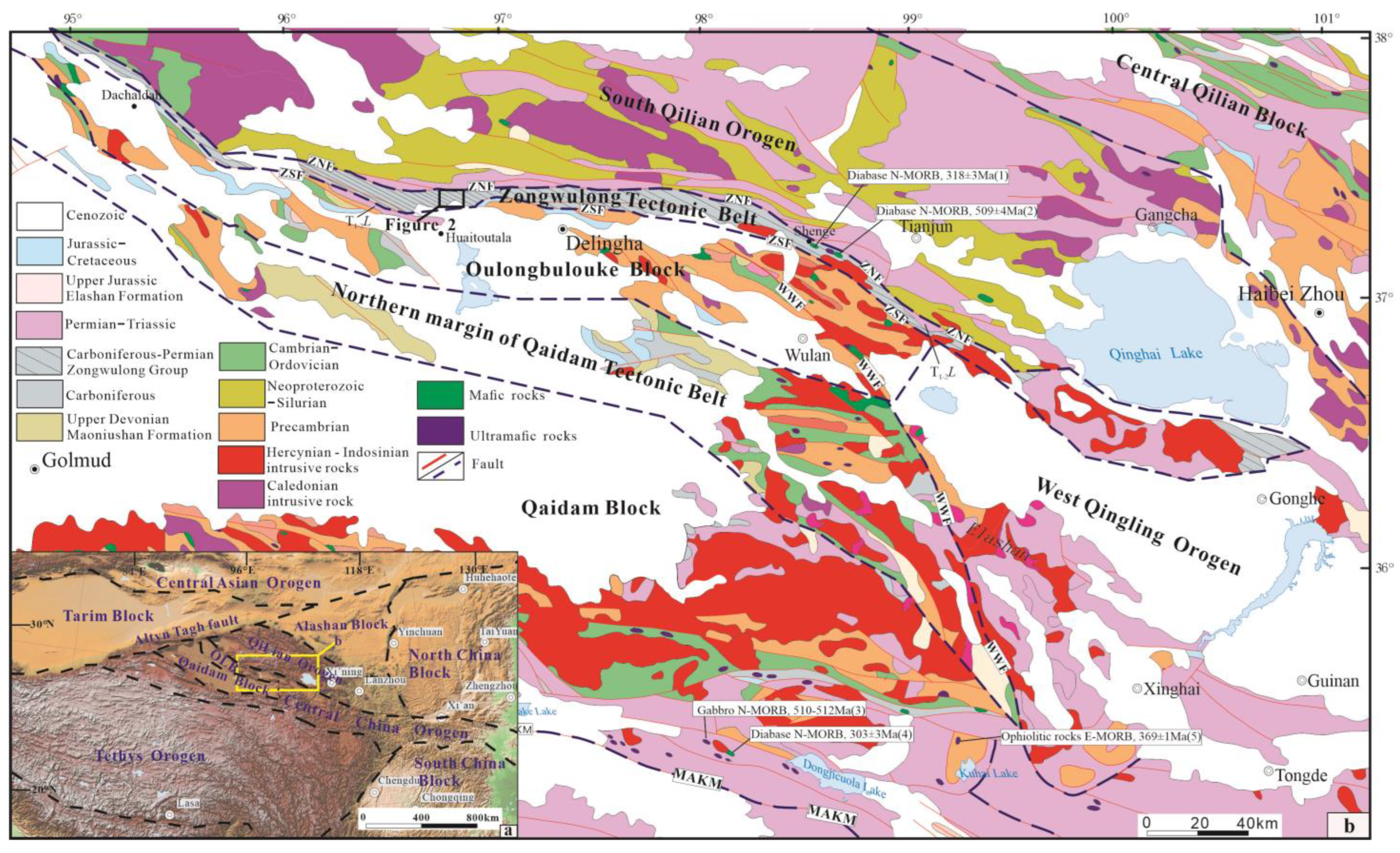





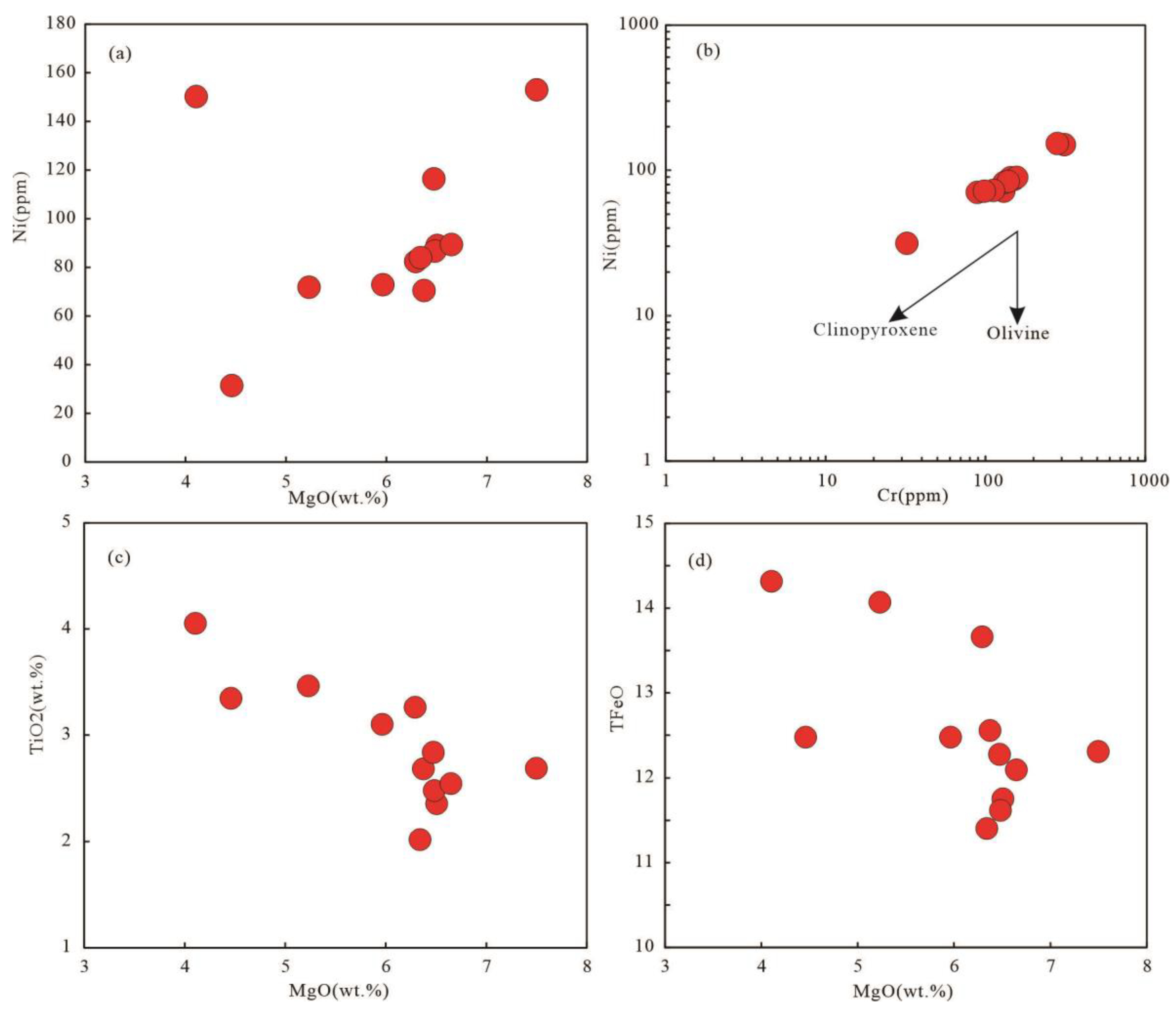
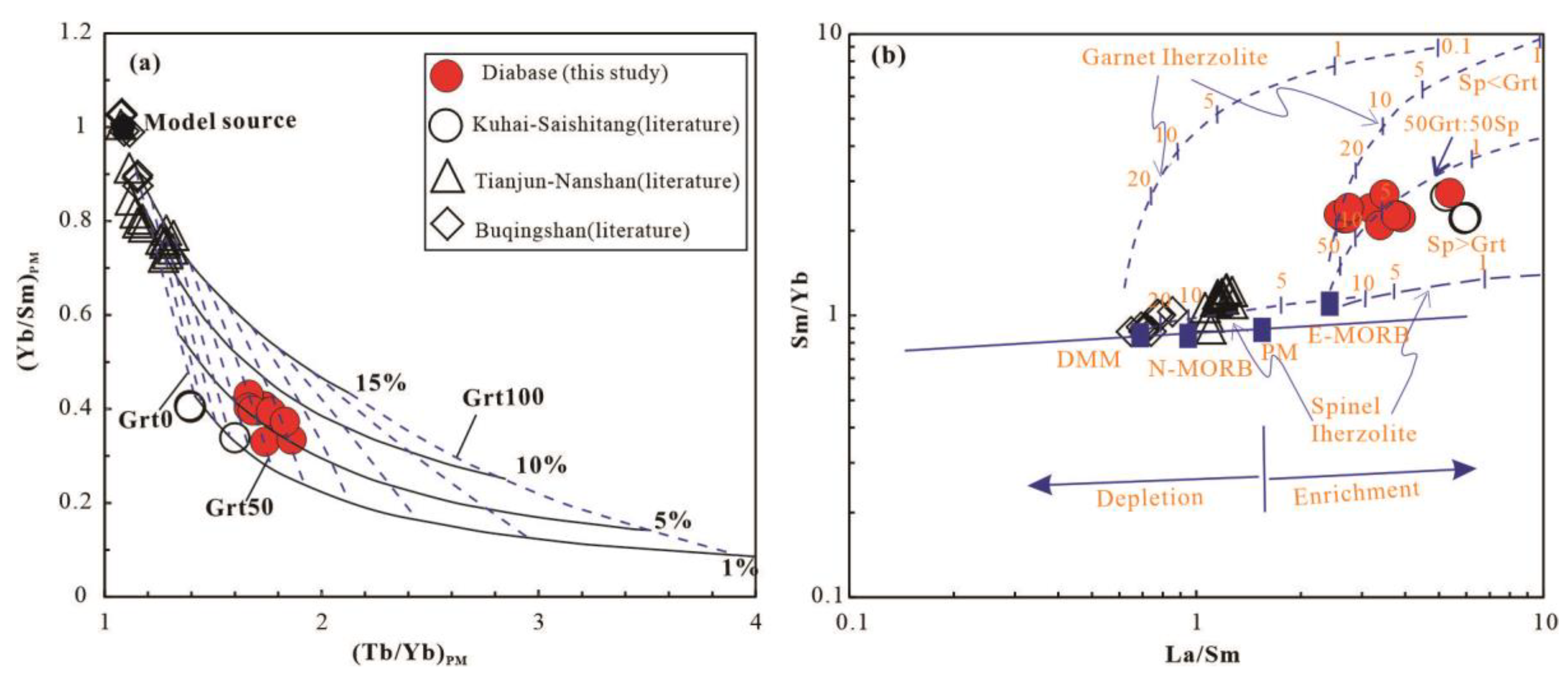

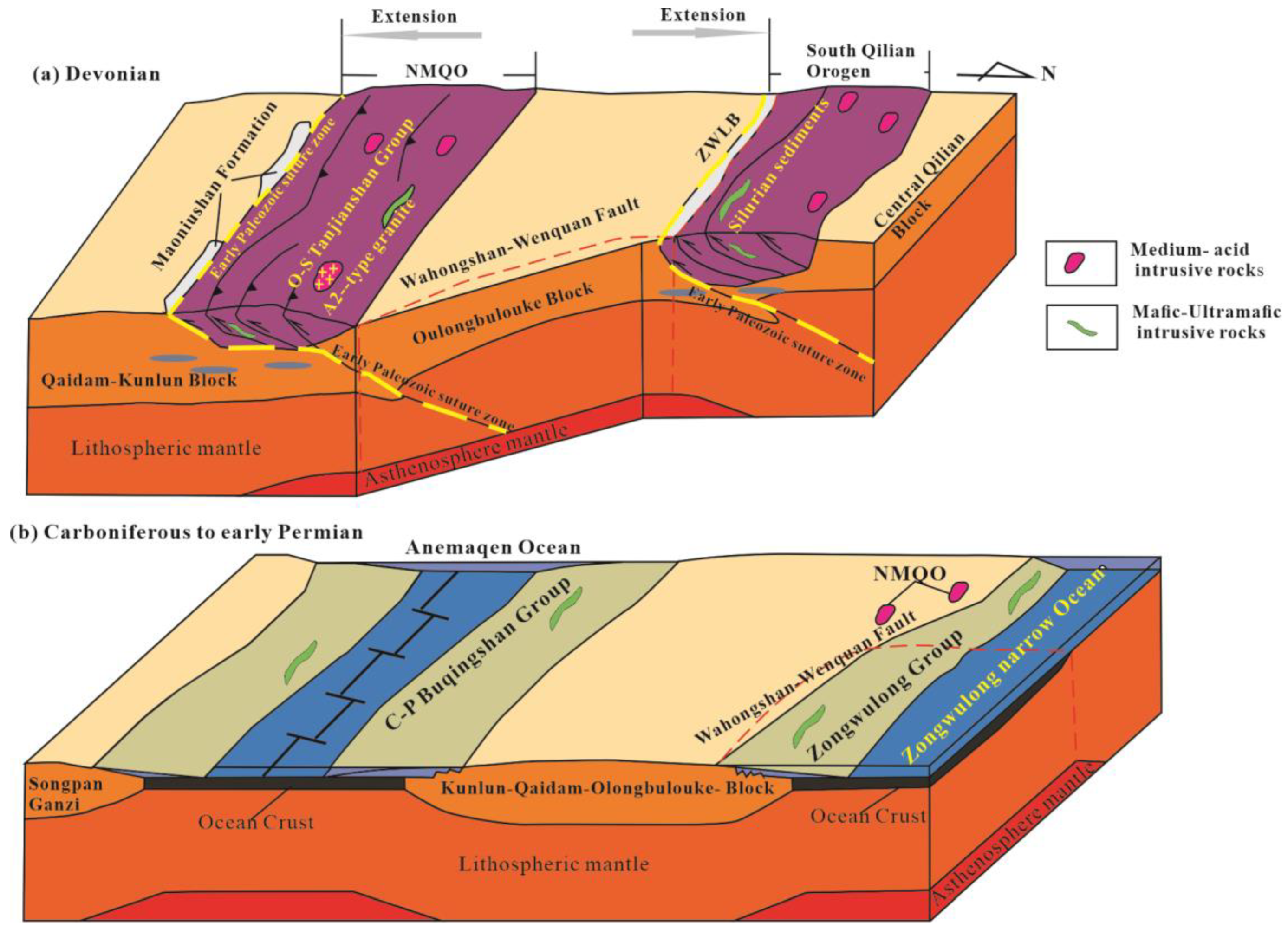
Disclaimer/Publisher’s Note: The statements, opinions and data contained in all publications are solely those of the individual author(s) and contributor(s) and not of MDPI and/or the editor(s). MDPI and/or the editor(s) disclaim responsibility for any injury to people or property resulting from any ideas, methods, instructions or products referred to in the content. |
© 2024 by the authors. Licensee MDPI, Basel, Switzerland. This article is an open access article distributed under the terms and conditions of the Creative Commons Attribution (CC BY) license (https://creativecommons.org/licenses/by/4.0/).
Share and Cite
Chen, M.; Pan, T.; Zhao, W.-T.; Wang, Y.-H.; Xue, C.-J.; Wang, B.-Z.; Xia, C.-L. Petrogenesis and Tectonic Setting of the Baluogenguole Mafic Dykes, Zongwulong Belt: Implications for Evolution of the Northern East Paleo-Tethys Ocean. Minerals 2024, 14, 473. https://doi.org/10.3390/min14050473
Chen M, Pan T, Zhao W-T, Wang Y-H, Xue C-J, Wang B-Z, Xia C-L. Petrogenesis and Tectonic Setting of the Baluogenguole Mafic Dykes, Zongwulong Belt: Implications for Evolution of the Northern East Paleo-Tethys Ocean. Minerals. 2024; 14(5):473. https://doi.org/10.3390/min14050473
Chicago/Turabian StyleChen, Min, Tong Pan, Wen-Tao Zhao, Yan-He Wang, Chun-Ji Xue, Bing-Zhang Wang, and Chu-Lin Xia. 2024. "Petrogenesis and Tectonic Setting of the Baluogenguole Mafic Dykes, Zongwulong Belt: Implications for Evolution of the Northern East Paleo-Tethys Ocean" Minerals 14, no. 5: 473. https://doi.org/10.3390/min14050473
APA StyleChen, M., Pan, T., Zhao, W.-T., Wang, Y.-H., Xue, C.-J., Wang, B.-Z., & Xia, C.-L. (2024). Petrogenesis and Tectonic Setting of the Baluogenguole Mafic Dykes, Zongwulong Belt: Implications for Evolution of the Northern East Paleo-Tethys Ocean. Minerals, 14(5), 473. https://doi.org/10.3390/min14050473



